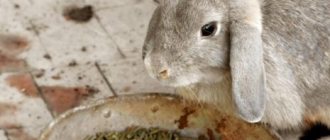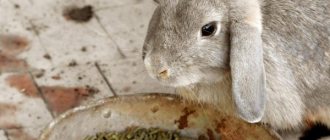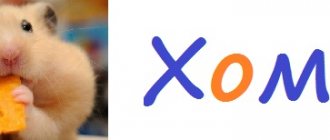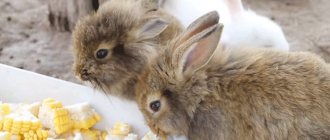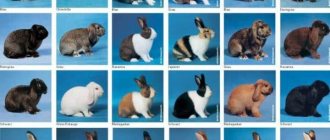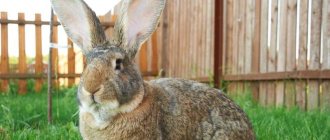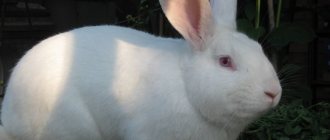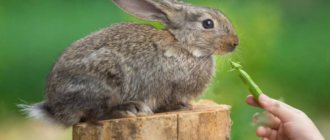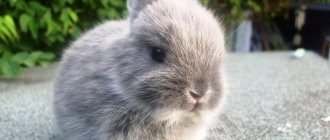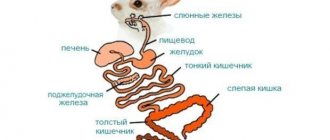Modern meat rabbit breeding is unthinkable without the use of special mixtures consisting of grain, grass granules and special additives. Compound feed for rabbits allows you to provide them with all the elements they need: nutrients, vitamins, microelements. For animals at different periods of life (pregnancy, fattening, resting state) there are different compositions of mixtures.
Types of feed
All rabbit food can be classified into one of three types:
- Roughage. These include grass, vegetable tops, cabbage, hay and tree branches. In winter, hay stored in the summer is fed as roughage. Roughage is the main supplier of fiber to animals.
- Juicy feed. These are root vegetables, silage, pumpkin, zucchini. As a rule, succulent feed ends up in the animal feeder during the winter. They serve as an essential source of vitamins, but are poor in fiber and protein. In lactating rabbits, large quantities of succulent feed increase the amount of milk.
- Concentrated feed. These include cereal grains and legumes, bran, cake, mixed feed, and animal feed. Concentrated feeds are rich in protein but poor in vitamins. With an increase in the dose of concentrated feed in the diet, the growth rate of animals increases.
Useful tips from MEGAMIX
The average calculation of daily feed for rabbits is per 1 kg of live weight and is 30-40 grams. A common addition to dry formulas is water and hay.
If desired, you can sometimes add grass, beets, leftovers from the beds and garden, and some grains to the diet.
Many breeders believe that any type of food is suitable for rabbits, even chicken or pork, but we should not forget the health features of these animals: often too much protein and improper consistency have a very detrimental effect on the health of the animal. Bird food often contains sand and shells, which are generally not suitable for rabbits.
All rabbit breeders should know that in no case should chocolate (this is the most toxic product for them), any cookies, potatoes, bakery and flour products, as well as any food from the table get into the animals' hands - this will only cause harm. It is better to give berries and fruits (up to 3 times a week), vegetables - up to three different varieties, and it is better to prefer greens rather than root vegetables.
What is compound feed, its advantages and disadvantages
Compound feed is a crushed and mixed mixture of plant and animal feed. During the cooking process, vitamins, macro- and microelements are added to it. For better absorption by the animal’s body, all components are selected according to their chemical composition, complementing each other. For each type of animal, feed is produced according to its own recipe.
Advantages:
- reduces time spent on feeding animals;
- easy to transport, convenient to store;
- feeding with compound feed makes the animal’s diet balanced, preventing health problems;
- the feed contains many components, thereby providing variety in animal nutrition;
- The vitamin premixes included in the feed save animals from vitamin deficiency.
Flaws:
- excessive amounts of feed leads to obesity in animals;
- compound feed – soft food. If they replace the bulk of the food, the rabbits' incisors will not wear down. This will lead to problems with the gastrointestinal tract;
- the cost of purchased mixtures is quite high.
Mash
The use of mash allows you to save feed. Mash is a wet mixture of feed with other ingredients, reminiscent of porridge. The following products are suitable for cooking:
- boiled potatoes or potato peelings;
- boiled vegetables: pumpkin, carrots, beets;
- silage;
- leftovers from the home table: soups, cereals, pasta, crackers, whey, ground eggshells.
The mash components are steamed with mixed feed and served warm in feeders. In the summer, rabbits should be fed them in small portions to prevent flies from landing on the food. In winter, it is also better to feed the mash in fractions to avoid freezing.
You can make a mash from leftover homemade food
Feed consumption rates
The norm depends on the age of the animal, physiological state and time of year. As a rule, there is usually a label on the packaging indicating how much of the product to give and to which animals.
According to the standards, for each animal it is necessary to allocate:
- adult rabbits – 180 grams;
- adult rabbits during the mating period - 230 grams;
- for female rabbits during pregnancy – 180 grams;
- nursing rabbits – 300 grams;
- young animals aged 1 month – 130 grams;
- at the age of 2 months – 150 grams;
- at the age of 3-4 months – 170 grams.
Compound feed is given to babies 5-6 times a day, to adult animals 2-3 times.
On a note! When feeding animal feed, animals must receive plenty of water.
Fat requirement
In adult rabbits and young animals, the standard requirement for fat is almost completely satisfied by its intake with food. Rabbit milk has a very high fat content (15-18%), which is 4-4.5 times higher than the fat content of cow's milk. In this regard, it is necessary to control the fat content in the diets of rabbits, especially young animals reared at an early age. It has been established that young rabbits develop poorly if the dry matter of the diet contains less than 5% crude fat.
Types of feed
The industry produces two types of combined feeds for rabbits:
- PC – fully rationed feed. Their composition fully satisfies all the needs of the animal body for nutrients, vitamins and microelements. When using this feed there is no need for additional feeding.
- Concentrated feeds are sold under the designation K or KK. This feed supplements the basic diet of animals with protein, fiber and minerals.
Different feed options are available for different ages of animals:
- for fattening young animals aged from one to five months, PK 90, PK 91, K91 are used;
- for feeding adult rabbits use K 92-1 and K 92-2;
- For final fattening of animals for meat, K93-1 compound feed is used.
Compound feed goes on sale in two states:
- granulated. An excellent option for complete feeding. Excellent storage, easy to dose, convenient for animals to eat;
- bulk mixtures. All components in them are ground into powder. It is most convenient to use them in mash.
On a note!
Feeding feed intended for other animals or birds can be harmful to rabbits due to the specific additives included in it.
Features of digestion in rabbits
Proper feeding of rabbits is impossible without knowledge of the peculiarities of their digestion. Rabbits have a fairly developed gastrointestinal tract, the length of which is 9-10 times greater than the length of the body. Moreover, only the thin section has a length of 3-4 m. Rabbits have a well-developed cecum, and its volume is 7-8 times larger than the stomach.
Digestion of nutrients in rabbits begins in the oral cavity, where the food is mechanically ground and moistened with saliva containing the enzyme diastase. Under its action, the starch of the feed turns into sugar. From the mouth, food enters the stomach. In it, under the action of the enzyme pepsin and hydrochloric acid, feed proteins are broken down into albumoses and peptones. It should be noted that the enzymatic activity of gastric juice in rabbits is significantly higher than in other herbivorous domestic animals.
From the stomach, the food mass is pushed into the duodenum, where further digestion of nutrients occurs. Under the influence of pancreatic enzymes, intestinal juice and bile, all nutrients in the feed are broken down - proteins, fats and carbohydrates. In the small intestine, breakdown occurs to amino acids, monosaccharides, glycerol, and fatty acids. Then they are absorbed into the blood and distributed throughout the body. Water and microelements are also absorbed in the small intestine. The digestion of food nutrients is completed in the large intestine (cecum, colon and rectum). In the cecum of rabbits, the digestion of nutrients ends, and fiber is also fermented.
The digestion of rabbits differs from other domestic animals by the presence of the act of coprophagy - eating their own soft feces. As a result, the rabbit’s body receives some of the nutrients that were not absorbed during their passage through the gastrointestinal tract. This feature is an important biological adaptation of the species to the harsh environmental conditions in which rabbits were before domestication (severe frosty winters, dry summers, etc.). However, the large intestine in rabbits is underdeveloped, so they do not effectively use high-fiber feeds.
What is feed made from?
Main components included:
- grain of wheat, barley, oats, corn;
- sunflower cake;
- legume grains: beans, peas, soybeans, lupine;
- oilseed grains: sunflower, rapeseed, rapeseed;
- roughage as a source of fiber;
- bran;
- bone flour;
- mineral, vitamin supplements, biostimulants.
In addition, to improve digestion, high-quality industrially produced feed includes:
You may be interested in: Industrial cages for rabbits at home: drawings How to make drinking bowls for rabbits with your own hands Cages for rabbits with your own hands: photos, original ideas
- acetic, ascorbic, benzoic and sorbic acids;
- ammonium hydroxide as a mold inhibitor;
- beet pulp – sugar production waste;
- source of calcium – limestone or calcium carbonate;
- source of protein – rapeseed flour, made from rapeseed after pressing the oil;
- B4 or choline chloride;
- preservative – citric acid. The use of citric acid helps to enhance growth and increase immunity in animals;
- flavoring additive – corn gluten;
- magnesium oxide;
- binding component and source of magnesium – black or cane molasses;
- source of phosphorus – monosodium phosphate;
- papaya to improve digestion;
- soybean hulls as a source of fiber;
- safflower flour as a source of protein;
- rosemary extract – a perfect natural antioxidant;
- safflower oil to improve taste;
- soybean meal is a source of protein;
- yucca to normalize the animal's gastrointestinal tract.
Self-production of feed
A prerequisite for this is the presence of a grain crusher. For complete mixing, all components must be ground to a homogeneous mass. To mix small volumes, you can use an electric drill with an attachment; for continuous feed production, it is easier to purchase a concrete mixer.
Full ration food recipe
- In a grain crusher, grain is ground into flour. 20% barley, 10% wheat, 10% corn, 5.5% soybeans are poured into the container.
- Add 40% of the volume of the container of chopped hay to the resulting mixture.
- Next, the sunflower cake is finely crushed and added in the amount of 10% of the volume.
- The total mass is filled with 2% feed yeast, 0.3% salt, 2.2% meat and bone meal.
The mixture is thoroughly mixed.
Determining the usefulness of purchased feed
Before purchasing feed, you must carefully study the label attached to it. The packaging must indicate what components the concentrate consists of, as well as the percentage of nutrients. In veterinary medicine, the following nutritional standards have been adopted for adult rabbits:
- raw fiber: more than 18%;
- indigestible elements: more than 12.5%;
- crude protein: 10 to 16%;
- fat: from 1 to 4%;
- calcium: from 0.6 to 1%;
- phosphorus: from 0.4 to 0.8%.
Food should contain vitamins:
- vitamin A: from 6,000 to 10,000 IU per kilogram;
- vitamin D: from 800 to 1200 IU per kilogram;
- vitamin E: from 40 to 70 mg per kilogram;
- trace elements: magnesium 0.3%, zinc 0.5%, potassium 0.6%.
Dr. Dana Krempels recommends the following ratio:
- fiber at least 22%;
- protein no more than 14%;
- fat 1%;
- calcium 1%.
On a note!
Young rabbits require food high in protein and fat.
Finding a feed composition that satisfies all the requirements is quite problematic, so when purchasing, pay attention to the most important factors. For an obese animal, the best choice would be a feed with a high amount of fiber and a reduced amount of fat, for an animal suffering from kidney problems - with a minimal amount of calcium.
Reviews
Nikolay, 37 years old
We have a large farm, so we specially go to the feed mill to buy feed. To save money, we buy concentrates, which we add to the main diet. We directly pour the granules into the feeders, and we dilute the loose feed and give it out in mash. After switching to specialized feed, our weight gain increased and the quality of the skins improved.
Elena, 29 years old
I have a small decorative rabbit, it eats very little, I buy a full ration of food for it at the pet store. Very convenient: the bag for the animal contains a specially selected composition of vitamins, fiber, proteins, protein, and microelements. There is no need to think about what to feed your pet - just pour granules into a cup, and all problems are solved. After eating, the rabbit is always cheerful and energetic, the fur is smooth and shiny.
In modern rabbit farming, the use of compound feed is a prerequisite for obtaining stable weight gain, high-quality wool and healthy offspring.
How to feed
Every rabbit breeder must monitor how animals eat and respond in a timely manner to emerging situations. It is common to eat only certain granules; the animal chooses only those pieces that it likes the most, and the most useful ones remain in the bowl. In this case, you must wait until the food is completely eaten and only then add the next portion.
If this happens constantly and some of the food remains in the feeder, then you need to reduce the daily norm, perhaps it is too high, or vice versa, the rabbits eat the mixture very quickly, then you need to slightly increase the weight of the portion.
In summer, the calculated norm is slightly less than in the cold period.
It is necessary to have water in the drinking bowl; it should always be fresh and clean, as well as in sufficient quantity.
Each package of feed for breeders contains all the information - who the mixture is intended for, what age it is intended for, average consumption rates and general recommendations for breed and weight.
If desired, in the summer, breeders often give preference to fresh grass and vegetables, but still use concentrated mixtures - they should be at least 20% of the total diet.
